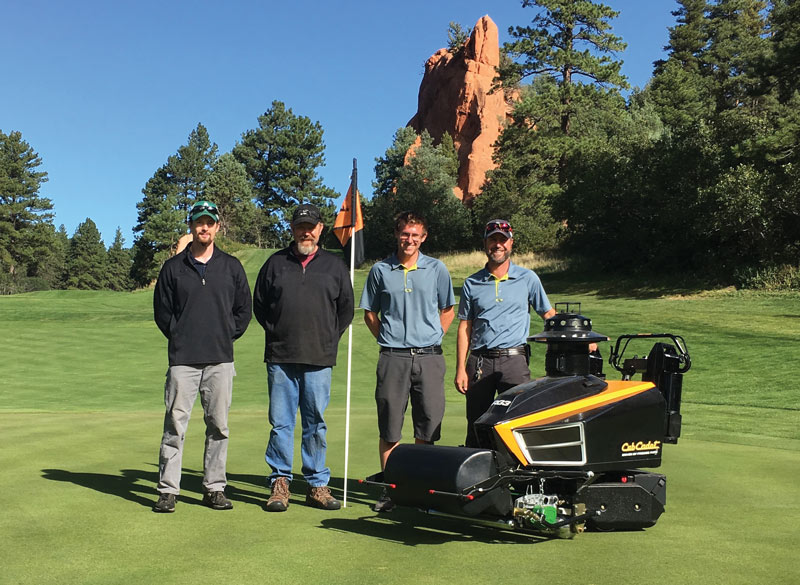
Perry Park Country Club second assistant Mike Eidel, equipment manager Nathan Brown, first assistant David Luna, superintendent Justin Daigle, and Reggie. Photo courtesy of Justin Daigle
This fall, Perry Park Country Club in Larkspur, Colo., became the third golf course in the U.S. to commit to robotic mowing of all putting greens, with superintendent Justin Daigle introducing a Cub Cadet RG3 to his equipment fleet (“Reggie” is the robot name that stuck). On a recent visit to see Daigle and Reggie at work, I learned about the RG3’s potential to make golf course maintenance more environmentally and financially sustainable.
Daigle, an 18-year GCSAA member, first encountered the RG3 at the 2015 Golf Industry Show in San Antonio. He explored the costs and benefits, and was intrigued by the prospect of Perry Park’s crew members being able to perform other duties as greens get mowed. While the RG3 requires an employee to set it up to mow, it gives staff back 26 minutes of time previously spent walk-mowing — time they can use to tackle other work nearby, such as hand-raking bunkers, edging heads, cleaning up debris, repairing ball marks, and filling divots. Through this efficiency, staff decreases trips around the course during second jobs, and tasks can be completed ahead of golfers’ arrival rather than as they play.
The RG3’s environmental advantages lie primarily in reduced fuel and oil use. The robot is 100 percent electric — no gas or oil is needed to operate it, which in turn eliminates all risk of leak damage to greens. The RG3 is powered by four sealed lead-acid batteries and is capable of mowing approximately six putting greens on one charge. Thanks to its 640-pound weight and three rollers, the RG3 does away with the need for a secondary speed roller. Typically, walk-mow crews employing traditional walk mowers use about 2.5 gallons of gas per day, along with about 1.5 gallons of gas for rolling. A complete fleet of RG3s cuts those amounts to zero, resulting in an overall fuel reduction of about 800 gallons per year. It is possible for a fleet of four robotic mowers with a seven-year life span to yield a total of $15,000 in fuel savings.
The technology behind the RG3 is backed by $30 to $40 million in research and development. The mower works within a quarter-inch margin of error on the cleanup, and about 2 inches on the stripes. With onboard artificial intelligence, the RG3 actually masters the nuances of each green and continues to compensate to improve mowing patterns. A human who is walk-mowing over a sloped surface will compensate by applying pressure to one side of the machine. The RG3 follows the same principle, equipped with independent odometers on each of its sides to account for varying conditions. A front-mounted radar on the RG3 detects any large objects in its path, and the machine will either slow down or stop based on the approaching object’s proximity and speed.
“Staff has been incredibly receptive to the technology, as it helps them provide a better product with less effort,” says Daigle, who has been the superintendent at Perry Park since 2004, and who says he was initially concerned about how employees would respond to the RG3. According to Daigle, the biggest payback has been in the quality of Perry Park’s putting surfaces. He estimates that to walk-mow a green, an operator averages 1,600 steps. Reggie’s zero footsteps and one-and-done mow-and-roll functionality thus foster a purer putting surface. Daigle has also found that the RG3, with its 14 blades and ability to ensure the perfect frequency of cut, produces 30 percent more clipping yield than his traditional walk mowers at the same height of cut. Members immediately experience significantly better putting conditions in comparison with those from standard walk-mow-and-roll preparation. (Just when I think putting surfaces can’t get any better, something like this happens: I sink a 50-foot putt on one of Perry Park’s RG3-perfect greens.)
No worries on being replaced by a robot — the RG3 and similar technologies simply allow superintendents to make golf course maintenance more efficient and eco-friendly. At Perry Park, Reggie not only furnishes incredible putting surfaces, but reduces the club’s environmental impact and frees up resources to deliver a better overall product.
Pamela C. Smith, CGCS, is an attorney and the director of agronomy for a large city. She is a 27-year member of GCSAA.